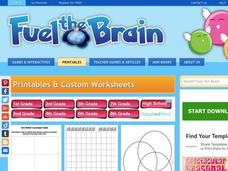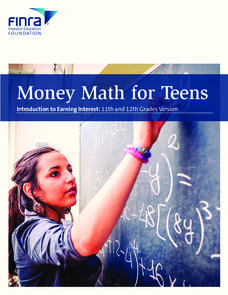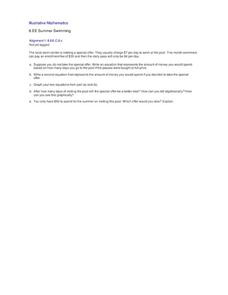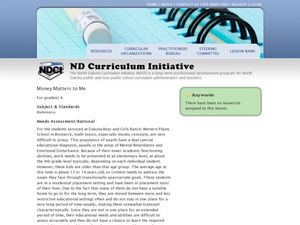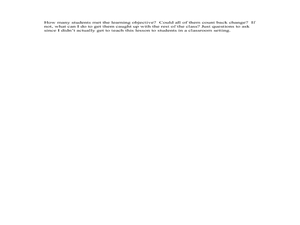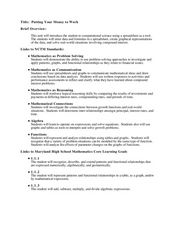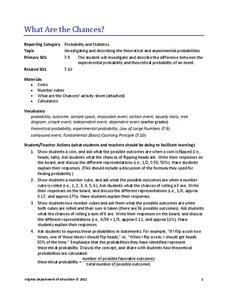Curated OER
Let's Find Out About Money
First graders identify coins (pennies, nickels, dimes and quarters), and their attributes, including physical characteristics and value.
Fuel the Brain
Counting Money
If your class understands the value of coins, this worksheet is a great way to assess that knowledge. Students are given an amount of each coin that Mia and Sarah have and will have to determine how much money in total each girl has.
SaveandInvest.org
Introduction to Earning Interest: Grades 9-10
Does your bank pay you for allowing them to hold your money? The lesson covers three different ways your money can make money. Topics include certificates of deposit, statement savings accounts, and money market accounts.
SaveandInvest.org
Introduction to Earning Interest: Grades 11-12
Does your bank pay you for allowing them to hold your money? Class members investigate three different ways money can make more money. Topics include certificates of deposit, statement savings accounts, and money market accounts....
Curated OER
Cutting Costs With Coupons.
Students clip coupons for food items, create a menu using those items, and add up the total savings. They correctly calculate the total amount of money that would be saved if they used the coupons.
Curated OER
Multiplication and Areas
Upper graders solve problems involving measurement of squares and rectangles to practice multiplication skills, finding area, and calculating prices and percentages. A performance assessment is included.
Bowland
Explorers – Patrol Services
Far out — plan a trip to space! Aspiring mathematicians steer a space vehicle through an asteroid field, calculate currency exchanges to buy provisions, and determine placement of charges to blow up asteroids. Along the way, they learn...
Curated OER
The Money of Great Britain
Students complete a KWL chart about money including what they would like to learn about the currency of Great Britain. In this British currency lesson, students read a text about this topic and view both American and British pictures of...
Illustrative Mathematics
Summer Swimming
Here is a real-world application for systems of equations. When is it better to pay an enrollment fee and lower daily rate, and when is it better to pay the regular price? The local swim center is having a special offer, reductions in...
Curated OER
Coin Carnival
Students investigate the value of coins. In this coin value lesson, students read The Penny Pot by Stuart Murphy. Students expand on skills learned in the book and engage in activities to determine the value of a mixed set of coins while...
Curated OER
Making Change
Second graders explore how to incorporate a new type of technology, the cash register and/or a calculator, as a motivational tool for solving real life problems. They practice estimating money and counting back change from $20.00.
Curated OER
Money Bags
First graders identify coins and their value. Using a mixed set of pennies, nickels, dimes, and quarters, they sort the coins and identify the name of each coin and the value of one coin in each set. As the teacher announces a given...
Federal Reserve Bank
Your Budget Plan
What do Whoosh and Jet Stream have in common? They are both characters in a fantastic game designed to help students identify various positive and negative spending behaviors. Through an engaging activity, worksheets, and...
Curated OER
Money Matters to Me
Fourth graders explore economics by identifying financial goals. In this consumerism activity, 4th graders discuss money matters and how to conserve an income when they get older in order to achieve their goals. Students collaborate in...
Curated OER
Changing the Different Currency of Different Countries
Students change the money used in different countries into our currency. In this algebra lesson plan, students rewrite word problems using variables and inequalities. They label each unknown with a letter and identify the steps needed to...
Curated OER
Money Game
Fourth graders give change of one dollar. In this decimal and fractions instructional activity, 4th graders receive fake coins and discuss what they could purchase with them. Students go for a walk and spend one dollar...
Curated OER
Money and Business (Art)
Third graders investigate world currency by creating their own coin art. In this government activity, 3rd graders examine the characteristics of different coins and create their own design for a new one. Students discuss and...
Curated OER
Building Tolerance for Poverty in Math
Students explore approximate and exact solutions. In this interdisciplinary lesson, 6th graders will be placed in 'family groups' to create a budget that is subject to random events as chosen from the 'things happen' box. This lesson...
Curated OER
Putting Your Money to Work
Students create a collect data on expenses. In this algebra lesson plan, students create a spreadsheet to solve scientific equations. They incorporate math, science and technology in this lesson plan.
Virginia Department of Education
What Are the Chances?
Take a chance on an informative resource. Scholars conduct probability experiments involving coins and number cubes to generate data. Compiling class data helps connect experimental probability to theoretical probability.
Practical Money Skills
Making Decisions
A set of quizzes and assessments would make a great companion to your lesson on making decisions and opportunity risks. Learners watch a PowerPoint before answering multiple choice questions about interest rates, saving money, and the...
Curated OER
Dollars and Sense
Fourth graders read "Starting a Business" and answer the question: "How could you design an ad to let the community know about the business described in the story?" Then, they illustrate a written ad that could be posted in the...
Curated OER
Technology - money
First graders trade coin amounts by using punch out coins. In this trading coins lesson plan, 1st graders use pennies, nickels, and dimes, and then trade them with each other in equivalent amounts. Students also complete money computer...
Curated OER
Money and Business
Third graders use play money to complete tasks that allow them to see if the budget they came up with works. In this budget lesson plan, 3rd graders create their own budget and test it out with the play money.

